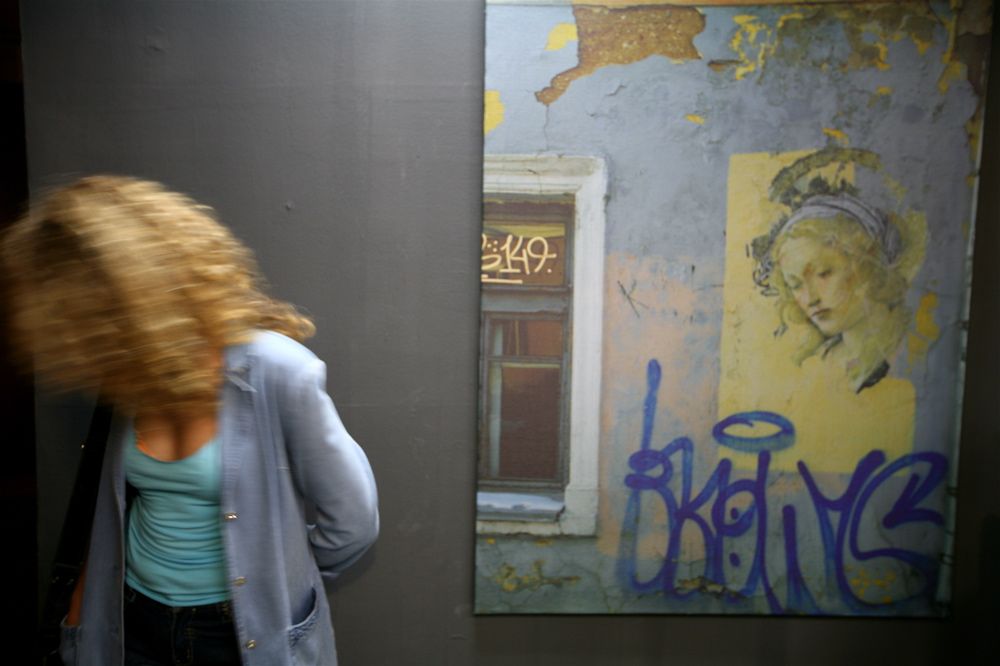The Moloko Bar sits halfway down a shaded alley a short walk from Minsk's Victory Square. You know you're on the right road when you see the avant-garde mural, a mash-up of Renaissance-era paintings and graffiti, that runs along the pavement, ending at a matte white building with a black "ў" by the door, the name of the attached art gallery. Such venues are around every corner in European cities like Berlin and Barcelona. But in the drab Belarusian capital, they are very much an exception.
Maria, a 29-year-old poet and journalist, told me over a milkshake that the bar/gallery complex is one of a handful of places in Minsk where brash, open-minded intellectuals can let off steam. Not too loudly, though: plain-clothes agents of the KGB (as the security agency is still called here) are known to stop by and eavesdrop. In their case, however, less plain would help. “Their clothes,” she says, “tell us who they are as soon as they walk through the door.”
The first time Maria and I met, "Casablanca" was playing silently on a flat-screen television mounted to the wall. In the smoky bowels of Rick’s Café Americain the Nazi Major Strasser was confronting Victor Laszlo, the Czech dissident. Coincidence? I couldn’t be sure. But the film was replayed as soon as it ended. As another activist would later assert, everything in Belarus is political when the context is understood.
That applies even to the names of hipster hangouts. The "ў" is a letter unique to the Belarusian alphabet, amounting to a kind of middle finger to state authorities. Since taking power in 1994, President Alyaksandr Lukashenka has systematically imposed Russian symbols and language on Belarus to consolidate his stale vision of a neo-Soviet state. The native tongue is essentially banned in schools and public places; violators have been punished with fines, beatings or prison time. This, of course, has turned Belarusian into a de-facto opposition code.
“Almost illegal,” says Maria, standing over a table of volumes at the bookshop next door to the milk bar. Gritty street photography, prose and erotic poetry: all in Belarusian. Ihar Lohvinau, the publisher of her first book, a meditation on the intellectual drain that afflicts the country, keeps an office at the back of the complex. He is said to be in perpetual debt—and under surveillance—because of his commitment to Belarusian authors. Print runs are typically limited to a few hundred copies.
The marginalisation faced by writers extends also to artists and musicians who are critical of the government. A growing number, like Lyapis Trubetskoy, a rock band, are on an unofficial blacklist that bans them from mention on state media (one of their music videos compares Mr Lukashenka to other dictators). The list is not restricted to local acts. Kevin Spacey, Jude Law and Kevin Kline are there, along with the Pet Shop Boys and Tom Stoppard, who is an outspoken supporter of Belarus's opposition.
Some artist-activists take a more oblique approach. Rusia, 31, another milk-bar regular, says she realised several years ago that “protest music doesn’t work any more.” She has since devoted herself to “reclaiming” traditional folk music, part of a cultural heritage she says the regime has repressed and manipulated. When not touring abroad, she gives free concerts in towns around the country. The response has been positive, she says, but apathy persists: “This country is made of fear.”
An undercurrent could be felt on the opening night of the latest exhibition at the ў gallery. Although music and wine were flowing, the young and beautiful in attendance spoke in hushed tones, casting furtive glances over their shoulders. The culture minister was there. Wearing a steel-grey suit and a hard expression, he nodded as the curator made her case for the works of Andrei Busel, a street artist. Evidently, he’s not a fan.
In a police state like this, Mr Busel’s metier—tagging 15th-century religious icons on to abandoned urban structures—might qualify as cutting-edge. But a Belarusian Banksy he is not. I asked him if there was any political symbolism to his creations. “I guess that’s not something I think about a lot when I work,” he said. “You can decide for yourself.”
His coyness could be forgiven. He was talking to a complete stranger. And although the minister had left, several KGB goons were still combing through the crowd.
